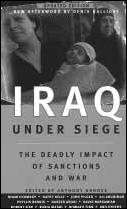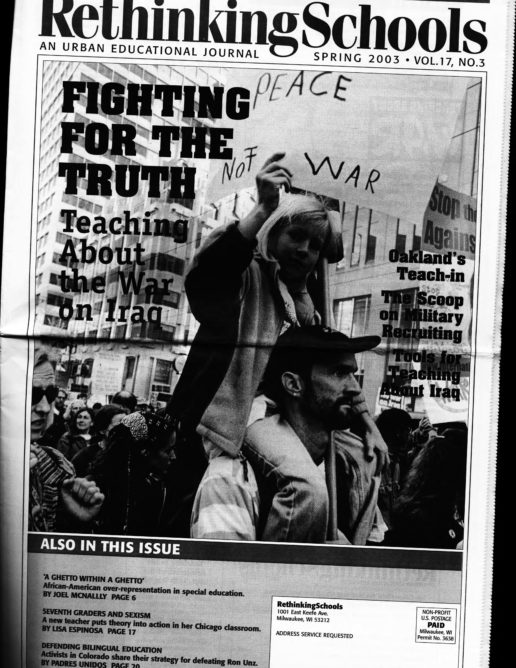Resources 17.3
Resources for teaching about war

*Addicted to War: Why the U.S. Can’t Kick Militarism, an Illustrated Exposé, Joel Andreas. (AK Press, 2002). 62 pp. $10. Takes on the most active, powerful, and destructive military in the world. Hard-hitting, carefully documented, and heavily illustrated, it reveals why the United States has been involved in more wars in recent years than any other country. Find out who benefits from these military adventures, who pays, and who dies.
Before and After: U.S. Foreign Policy and the September 11 Crisis, Phyllis Bennis. (Olive Branch Press, 2003). www.interlinkbooks.com. Includes valuable history of U.S., Israeli, Palestinian relations. Strong history of U.S. domination of U.N. and the evolving policy of U.S. unilateralism.
Challenge to Genocide: Let Iraq Live, Ramsey Clark et al, ed. (International Action Center, 1998). www.iacenter.org. The first chapter, “Fire and Ice,” by Clark, contains powerful unreported information on the devastation caused by the 1991 war and sanctions.
*Hidden Wars of Desert Storm (video), Audrey Brohy and Gerald Ungerman. (Free-Will Productions, 2000). 64 minutes. $25. This documentary looks at the origins of the Gulf War crisis and challenges the official Western “party-line” view of a spontaneous crusade for “Freedom & Democracy.” It exposes the White House and U.S. State Department’s hidden agenda in the Gulf as well as the Pentagon’s use of radioactive ammunitions made of uranium 238, backed by interviews of such prominent personalities as Desert Storm Commander General Norman Schwarzkopf, former Attorney General Ramsey Clark, and many others.
Iraq Under Siege: The Deadly Impact of Sanctions and War, Anthony Arnove, ed. (South End Press, 2002). 262 pp. $16. A powerful collection of essays by scholars such as Noam Chomsky, Phyllis Bennis, and Howard Zinn that deal with all aspects of the current conflict in Iraq. A key primer.
Let Iraq Live (video), Gloria Riva. International Action Center. 28 minutes. $17. www.iacenter.org.
No-Nonsense Guide to The Arms Trade, Gideon Burrows. (New Internationalist/Verso, 2002). 144 pp. $10. An excellent description of the world trade of death products, from small arms to jet fighters. A valuable resource for socially conscious math teachers, global studies, or social studies teachers. Part of an extremely useful series that every school library should have.
Target Iraq: What the News Media Didn’t Tell You, Norman Soloman and Reese Erlich. (Context Books, 2003). Excellent, specific discussions of media bias and war rhetoric.
Understanding the U.S.-Iraq Crisis: A Primer, Phyllis Bennis. (Institute for Policy Studies, January 2003). 24 pp. An excellent resource that answers 43 basic questions about the current march to war, the history of U.S.-Iraq relations, and alternatives to the current policy. An electronic version of the publication can be found at https://ips-dc.org/?s=iraq+primer. Printed copies available at low prices. Check out the above website, or contact 202-234-9382 or dorian@ips-dc.org.
Why Another War? A Backgrounder on the Iraq Crisis (Second Edition), Sarah Graham- Brown and Chris Toensing. (MERIP Report, December 2002). 16 pp. Primer offers answers to major questions on the Iraq crisis including: Does Saddam Hussein’s regime pose a “mortal threat” to the U.S. and Iraq’s neighbors? How have sanctions imposed after Iraq’s 1990 invasion of Kuwait affected ordinary Iraqis? The Iraq backgrounder is available online at: www.merip.org or in print form at no charge, while supplies last. To order copies or for further information, contact MERIP at ctoensing@merip.org or call 202-223-3677.
Organizations Against the War
American-Arab Anti-Discrimination Committee
www.adc.org. An essential resource for countering bias against Arabs and for current coverage about harassment of immigrants and Arab Americans.
A.N.S.W.E.R.
www.internationalanswer.org
A coalition organizing against the war and racism.
Education for Peace in Iraq
www.epic-usa.org
Resources for education and activism.
Middle East Report
www.merip.org
Offers astute analyses of events in the Middle East.
National Network to End the War Against Iraq
www.endthewar.org
Chronicles anti-war activism, present and past.
Not in Our Name
www.notinourname.net
A national call to resist the war.
United for Peace
www.unitedforpeace.org
Coordinates work against U.S. war on Iraq.
Voices in the Wilderness
www.nonviolence.org/vitw/
An organization that defies the sanctions against Iraq.
Policy/Curriculum
*EmBodying Equity: Body Image as an Equity Issue: A Manuel for Educators and Service Providers, Carla Rice and Vanessa Russell. (Green Dragon Press, 2002). 170 pp. $43. A creative and practical resource that addresses the intersections of body image, identity, oppression, and equality. With a blend of theory and more than 50 practical interactive exercises, this resource will help teachers empower young people to move toward social action.
*Kids Like Us: Using Persona Dolls in the Classroom,Trisha Whitney. (Redleaf Press, 1999). 232 pp. $25. This book makes it easy to use persona dolls in the classroom. Provides practical and inspirational tips for working with children and the dolls. Includes detailed descriptions and examples.
Phonics Exposed, Richard Meyer. (Erlbaum Associates, 2002). 180 pp. $19.95. An easy-to- read critique of systematic direct intense phonics instruction. This timely book explains both the general political context and consequences of the phonics mania, including a very specific description of problems teachers face when forced to use this method.
*A School of Our Own: Parents, Power, and Community at the East Harlem Block Schools,Tom Roderick. (Teachers College Press, 2001). 180 pp. $22. Shows how in 1965 a group of Puerto Rican “homemakers” created better schools for their children and built a community that enabled many adults to transform their lives. Highlighted are both the educational and political struggles.
Picture Books
Jemma’s Journey, Trevor Romain, illustrated by Pat Lopez. (Boyds Mill Press, 2002). Unpaged. $15.95. A well-illustrated story of a little girl’s reaction to her grandmother’s mention of the lynching of a Black man that took place on Nov. 2, 1920, in Ocoee, Florida. A good place to begin discussing voting rights and lynching with young children. The story would have been stronger and more accurate if the author had fully described the white attack on Black people and if he hadn’t written it in the passive tense. White mobs destroyed the entire black community of Ocoee, including 25 homes, two churches, and the Masonic temple. Less than three years later, the nearby town of Rosewood met a similar fate. Teacher notes should have been included with this book. For more information on the incidents, see: www.displaysforschools.com/rosewood.html.
Madoulina: A Girl Who Wanted to Go to School, Joël Eboueme Bognomo. (Boyds Mill Press, 2002). Unpaged. $14.95. A story from Cameroon, Africa, in which an eight-year-old girl struggles with her family’s poverty in order to fulfill her dream of going to school and eventually becoming a doctor. Useful in discussion of issues of poverty, child labor, and sexism.
*All the Colors We Are/Todos los colores de nuestra piel: The Story of How We Get Our Skin Color/La historia de por qué tenemos diferentes colores de piel, Katie Kissinger, photos by Wernher Krutein. (Redleaf Press, 1994). 32 pp. $10. Magnificent photographs and simple, engaging language capture the essence of one way we are special and different from one another — our skin color! Answers the “what and why” questions that children love to ask. Includes unique activity ideas. Bilingual English/Spanish.
*Titles from the Teaching for Change catalog.

